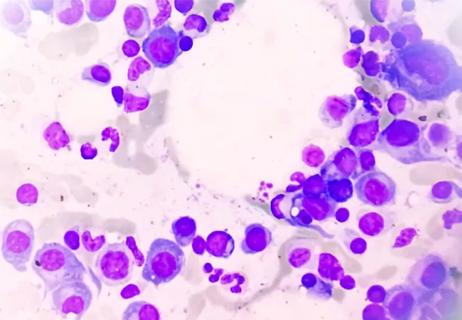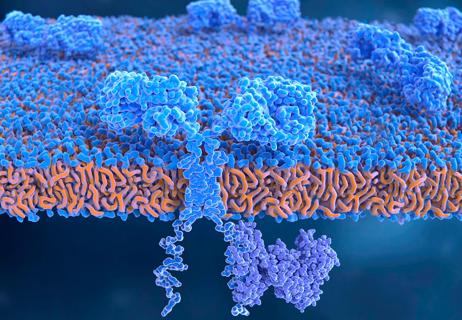Clinical trial tests effectiveness of fluorescence-guided sentinel lymph node imaging

Greater surgical precision, equivalent or better sentinel lymph node (SLN) mapping and increased patient convenience — Cleveland Clinic investigators intend to assess these and other potential benefits of fluorescence-guided SLN detection by comparing the new technology with the use of a traditional radiocolloid tracer for breast cancer surgery.|
Cleveland Clinic is a non-profit academic medical center. Advertising on our site helps support our mission. We do not endorse non-Cleveland Clinic products or services. Policy
SLN biopsy is the standard of care for axillary staging in breast cancer. While radiocolloid tracers produce high SLN detection rates, the method is expensive and requires special facilities, equipment and expertise. Near-infrared fluorescence-guided SLN mapping is a promising alternative that enables the surgeon to visualize subcutaneous lymphatic flow in real time intraoperatively.
“Technology continues to develop that allows us to perform fluorescence-guided surgery,” says Stephen Grobmyer, MD, Cleveland Clinic’s Director of Breast Surgical Oncology, Co-Director of the Comprehensive Breast Cancer Program and the study’s principal investigator. Although the research focuses on the role of fluorescent indocyanine green (ICG) in women with stage 1 or 2 breast cancer, “in cancer surgery in general this technology may have a bigger role.”
In one of the first trials of its kind in the United States, Dr. Grobmyer and his collaborators are comparing ICG with technetium-99m (99m Tc) sulfur colloid radiotracer in women scheduled for lumpectomy or mastectomy. They will compare the number of nodes removed and the proportion that test positive for malignancy using each detection method.
“The best-case scenario for the ICG would be if all the nodes in the study that are cancerous are fluorescent,” Dr. Grobmyer says. “So if you have 100 patients, and 30 of those have cancer in the sentinel nodes, ideally in every case that would be picked up by fluorescence.”
Traditionally, breast cancer surgeons operate on what they can see at the surface. “With fluorescence imaging, we can see deeper,” Dr. Grobmyer says. “If you’re looking with your eye, you might not even see a node there. But because the fluorescence can travel up to 1 cm, you can see the glow under the tissue, so you know exactly where to go down and do your dissection.”
For the study, the researchers will administer a 99m Tc injection the day or morning before surgery. All patients will undergo standard lymphoscintigraphy. In addition, just prior to surgery, physicians will inject ICG solution close to the tumor or into the subareolar region of the breast skin. They will lower the operating room lights and monitor lymphatic drainage in real time using a near-infrared camera connected to a monitor.
“One of the things we’re studying is whether this technology of image-guided sentinel node surgery can replace some of the current technology, which has some limitations,” Dr. Grobmyer says.
Traditionally, surgeons inject a radioactive tracer such as 99m Tc into the breast. The tracer’s radioactivity makes this technique more complicated, including the need for a federal nuclear materials license. Intermittent national shortages of 99m Tc are another limitation.
The radiotracer approach is also less convenient for patients. “Most of the time the injection is done before surgery, so the patient is awake and it often involves another trip to the doctor,” Dr. Grobmyer says. “We want to avoid the risks and patient discomfort.”
In contrast, surgeons can inject ICG in the operating room with the patient already anesthetized. Seeing the real-time fluorescent flow in the lymphatics allows physicians to “make an incision right over the area where the node is,” Dr. Grobmyer says.
Measuring the time it takes for the dye to travel from the breast to the lymph nodes is a secondary objective of the study. “That’s an important thing because if it takes an hour for the material to map, it wouldn’t be a great use of your operating room resources,” he says. “We think it’s going to be on the order of five to 10 minutes.”
If the fluorescence-guided technique for SLN identification proves more precise than the radiocolloid approach, it could reduce the extent of tissue removal and the invasiveness of surgery, Dr. Grobmyer says. In addition, ICG may save money by obviating the need for radiocolloid injection and nuclear imaging. The cost analysis has yet to be done.
Investigators in Japan have more experience using ICG fluorescence to guide tumor detection. “The Japanese demonstrate very good results using this technique, which in some cases appears superior to current techniques,” Dr. Grobmyer says.
For example, a study of 821 women found that ICG fluorescence and radioisotope were equivalent in overall SLN detection (97.2 percent and 97.0 percent, respectively). The detection rate for tumor-positive SLN was 93.3 percent for ICG and 90.0 percent for radioisotope. Japanese ICG studies also suggest efficacy for detection of hepatoblastomas and use in gastrointestinal surgery to better distinguish bile duct anatomy.
“In the United States, we are in the infancy of using fluorescence to guide cancer surgery,” Dr. Grobmyer says. “There’s a lot we’re going to learn from this trial. This is an example of the future of fluorescence in guiding cancer surgery.”
The study, “Comparison of Use of Indocyanine Green and 99mTc-labeled Radiotracer for Axillary Lymphatic Mapping Patients with Breast Cancer (ICG),” is sponsored by the Case Comprehensive Cancer Center, the National Cancer Institute and Miktaka USA Inc., which supplied the photodynamic eye camera and related equipment. Further trial details can be found at ClinicalTrials.gov.

New program provides prehabilitation and rehabilitation services to help patients with cancer maintain and regain function

Consult program a valuable tool that benefits both patients and clinicians

Additional fine-tuning and recruiting of new patient groups underway

Driving advances in cancer care

Patient able to avoid surgery and radiation despite having rapidly growing mass

Minimal residual disease testing shows promising results

Immune therapy and targeted therapies have led to durable responses and potential cures

A brief look at our programs